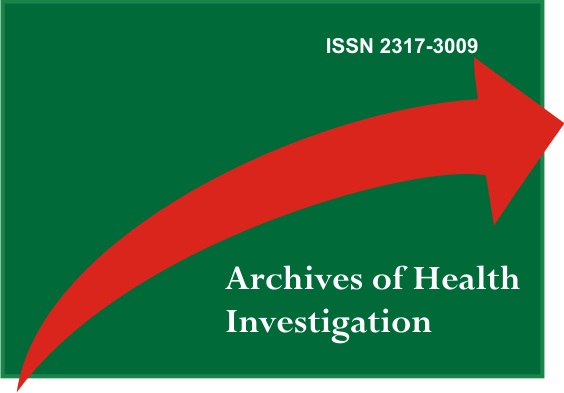Aesthetic-Functional Restoration of Teeth with Molar-Incisor Hypomineralization: Case Report
DOI:
https://doi.org/10.21270/archi.v12i5.5791Keywords:
Tooth Demineralization, Dental Enamel, Pediatric Dentistry, Dental Enamel HypoplasiaAbstract
Introduction: Molar-incisor hypomineralization (MIH) is a developmental disorder of systemic origin and unknown etiology that affects first permanent molars and incisors. Clinically, the enamel of affected teeth shows areas of white/opaque, yellow or brown discoloration. The treatment of this alteration involves the application of fluoride (F), direct restorations and even extractions, depending on the severity of the case. Objectives: This study aimed to report and describe the conduct of a clinical case of molar-incisor hypomineralization (MIH). Case Report: A 10-year-old male pediatric patient attended at the Pediatric Dentistry Clinic of the University of Ribeirão Preto-UNAERP was diagnosed with MIH based on anamnesis and clinical examination and proposed a treatment plan for aesthetic and functional rehabilitation, with clinical follow-up. After the child's conditioning was performed, the child showed fear, anxiety and a cooperative behavior with reserve during the appointments, behaving with impatience and agitation in the dental chair. Given the case, restorations with composite resin was performed on teeth 16, 26 and 11. After the treatment, the functional, aesthetic and masticatory rehabilitation of the patient was possible, in addition to attenuating their sensitivity, thus improving their self-esteem. Conclusion: The treatments performed provided an improvement in the patient's sensitivity and functional and esthetic rehabilitation of teeth affected by HMI, in addition, actively improving the quality of life and self-esteem of this child.
Downloads
References
Fragelli CMB, Souza JF de, Jeremias F, Cordeiro R de CL, Santos-Pinto L. Molar incisor hypomineralization (MIH): conservative treatment management to restore affected teeth. Braz Oral Res. 2015;29:806 – 8324201500010027
Weerheijm KL, Groen HJ, Beentjes V, Poorterman JHG. Prevalence of cheese molars in eleven-year-old Dutch children. J Dent Child. 2001;68(4):259-62.
Garot E, Denis A, Delbos Y, Manton D, Silva M, Rouas P. Are hypomineralised lesions on second primary molars (HSPM) a predictive sign of molar incisor hypomineralisation (MIH)? A systematic review and a meta-analysis. J Dent. 2018;72:8-13.
Weerheijm KL. Molar incisor hypomineralization (MIH): clinical presentation, aetiology and management. Dent Update. 2004;31(1):9-12.
William V, Messer LB, Burrow MF. Molar incisor hypomineralization: review and recommendations for clinical management. Pediatr Dent. 2006;28(3):224-32.
Garg N, Jain AK, Saha S, Singh J. Essentiality of early diagnosis of molar incisor hypomineralization in children and review of its clinical presentation, etiology and management. Int J Clin Pediatr Dent. 2012;5(3):190-6.
Weerheijm KL, Mejàre I. Molar incisor hypomineralization: a questionnaire inventory of its occurrence in member countries of the European Academy of Paediatric Dentistry (EAPD). Int J Paediatr Dent. 2003;13(6):411-6.
Giacaman RA, Muñoz-Sandoval C, Neuhaus KW, Fontana M, Chałas R. Evidence-based strategies for the minimally invasive treatment of carious lesions: Review of the literature. Adv Clin Exp Med. 2018;27(7):1009-16.
Lygidakis NA. Treatment modalities in children with teeth affected by molar-incisor enamel hypomineralisation (MIH): A systematic review. Eur Arch Paediatr Dent. 2010;11(2):65-74.
Sundfeld D, da Silva L, Kluppel OJ, Santin GC, de Oliveira R, Pacheco RR et al. Molar Incisor Hypomineralization: Etiology, Clinical Aspects, and a Restorative Treatment Case Report. Oper Dent. 2020;45(4):343-51.
de Souza JF, Fragelli CB, Jeremias F, Paschoal MAB, Santos-Pinto L, de Cássia Loiola Cordeiro R. Eighteen-month clinical performance of composite resin restorations with two different adhesive systems for molars affected by molar incisor hypomineralization. Clin Oral Investig. 2017;21(5):1725-33.
da Cunha Coelho ASE, Mata PCM, Lino CA, Macho VMP, Areias CMFGP, Norton APMAP et al. Dental hypomineralization treatment: A systematic review. J Esthet Restor Dent. 2019;31(1):26-39.
Fütterer J, Ebel M, Bekes K, Klode C, Hirsch C. Influence of customized therapy for molar incisor hypomineralization on children's oral hygiene and quality of life. Clin Exp Dent Res. 2020;6(1):33-43.
Laureano ICC, Farias L, Fernandes LHF, Alencar CRB, Forte FDS, Honório DR et al. Dental Fear in Children: Association with Dental Caries and Molar Incisor Hypomineralization. Braz Dent J. 2020;31(6):673-79.
Jälevik B, Sabel N, Robertson A. Can molar incisor hypomineralization cause dental fear and anxiety or influence the oral health-related quality of life in children and adolescents? a systematic review. Eur Arch Paediatr Dent. 2022;23(1):65-78.
Elhennawy K, Schwendicke F. Managing molar-incisor hypomineralization: A systematic review. J Dent. 2016;55:16-24.
Lygidakis NA, Chaliasou A, Siounas G. Evaluation of composite restorations in hypomineralised permanent molars: a four year clinical study. Eur J Paediatr Dent. 2003;4(3):143-8.
Mathu-Muju K, Wright JT. Diagnosis and treatment of molar incisor hypomineralization. Compend Contin Educ Dent. 2006;27(11):604-10.
Modaresi J, Dianat O, Mozayeni MA. The efficacy comparison of ibuprofen, acetaminophen-codeine, and placebo premedication therapy on the depth of anesthesia during treatment of inflamed teeth. Oral Surg Oral Med Oral Pathol Oral Radiol Endod. 2006;102(3):399-403.


